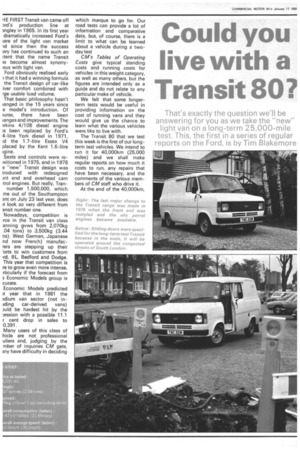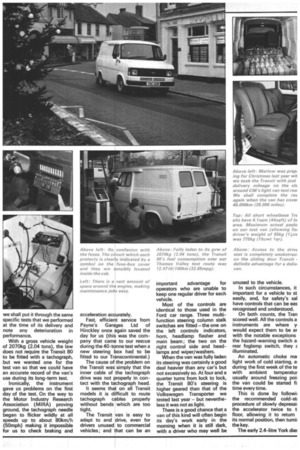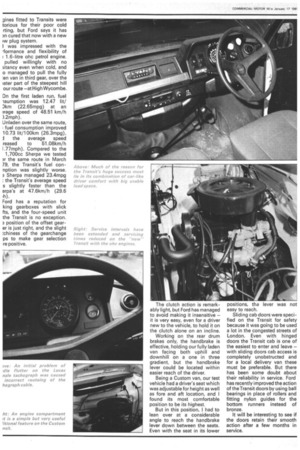Could you live with a Transit 80?
Page 56

Page 57

Page 58

Page 59

If you've noticed an error in this article please click here to report it so we can fix it.
That's exactly the question we'll be answering for you as we take the "new" light van on a long-term 25,000-mile test. This, the first in a series of regular reports on the Ford, is by Tim Blakemore
HE FIRST Transit van came off prd's production line at ]ngley in 1965. In its first year dramatically increased Ford's tare of the light van market Id since then the success ory has continued to such an ;tent that the name Transit Is become almost synonyous with light van.
Ford obviously realised early that it had a winning formula the Transit design of car-like iver comfort combined with rge usable load volume.
That basic philosophy hasn't tanged in the 15 years since e model's introduction. Of iurse, there have been lenges and improvements. The :rkins 4/108 diesel engine is been replaced by Ford's 4-litre York diesel in 1971, id the 1.7-litre Essex V4 placed by the Kent 1.6-litre Seats and controls were reisitioned in 1975, and in 1978 e "new" Transit design was troduced with redesigned mit end and overhead cam Aro! engines. But really, Trannumber 1,500,000, which me out of the Southampton ant on July 23 last year, does it look so very different from ansit number one.
Nowadays, competition is Ice in the Transit van class anning gvws from 2,070kg .04 tons) to 3,500kg (3.44 ns). West German, Japanese nd now French) manufacrers are stepping up their 'orts to win customers from
BL, Bedford and Dodge. This year that competition is re to grow even more intense, rticularly if the forecast from a Economic Models group is curate.
Economic Models predicted ;t year that in 1981 the )dium van sector (not inkling car-derived vans) )uld be hardest hit by the .lession with a possible 11.1 r cent drop in sales to 0,391.
Many users of this class of hide are not professional uliers and, judging by the mber of inquiries CM gets, my have difficulty in deciding which marque to go for. Our road tests can provide a lot of information and comparative data, but, of course, there is a limit to what can be learned about a vehicle during a twoday test CM's Tables of Operating Costs give typical standing costs and running costs for vehicles in this weight category, as well as many others, but the figures are intended only as a guide and do not relate to any particular make of vehicle.
We felt that some longerterm tests would be useful in providing information on the cost of running vans and they would give us the chance to learn what the various vehicles were like to live with.
The Transit 80 that we test this week is the first of our longterm test vehicles. We intend to run it for 40,000km (25,000 miles) and we shall make regular reports on how much it costs to run, any repairs that have been necessary, and the comments of the various members of CM staff who drive it.
At the end of the 40,000km, we shall put it through the same specific tests that we performed at the time of its delivery and note any deterioration in performance.
With a gross vehicle weight of 2070kg (2.04 tons), the law does not require the Transit 80 to be fitted with a tachograph, but we wanted one for the test van so that we could have an accurate record of the van's use during its long-term test.
Ironically, the instrument gave us problems on the first day of the test. On the way to the Motor Industry Research Association (MIRA) proving ground, the tachograph needle began to flicker wildly at all speeds up to about 80km/h (50mph) making it impossible for us to check braking and acceleration a urately.
Fast, efficie t service from Payne's Ga ges Ltd of Hinckley once again saved the day for us (thi was the company that came to our rescue during the 40-tonne test when a new steering pox had to be fitted to our T7nscontinental.) The cause of the problem on the Transit was simply that the inner cable of the tachograph drive was not Properly in contact with the tachograph head.
It seems that on all Transit models it is difficult to route tachograph cables properly without bends which are too tight.
The Transit van is easy to adapt to and drive, even for drivers unused to commercial vehicles; and that can be an
important advantage for operators who are unable to keep one regular driver for each vehicle.
Most of the controls are identical to those used in the Ford car range. Three multifunction steering column stalk switches are fitted —the one on the left controls indicators, horn, headlamp flasher and main beam; the two on the right control side and headlamps and wiper/washers.
When the van was fully laden its steering was certainly a good deal heavier than any car's but not excessively so. At four and a quarter turns from lock to lock, the Transit 80's steering is higher geared than that of the Volkswagen Transporter we tested last year — but nevertheless it was not as light There is a good chance that a van of this kind will often begin its day's work early in the morning when it is still dark, with a driver who may well be unused to the vehicle.
In such circumstances, it important for a vehicle to st easily, and, for safety's sal have controls that can be eas recognised and understood.
On both counts, the Tran scored well. All the controls a instruments are where y, would expect them to be ar with the notable exceptions the hazard-warning switch a rear foglamp switch, they E illuminated.
An automatic choke ma. light work of cold starting, al during the first week of the te with ambient temperatur usually around freezing poii the van could be started fi time every time.
This is done by followii the recommended cold-st; procedure of slowly depressii the accelerator twice to t floor, allowing it to return its normal position, then tumii the key.
The early 2.4-litre York die; gines fitted to Transits were torious for their poor cold rting, but Ford says it has pn cured that now with a new ow plug system.
I was impressed with the iormance and flexibility of 1.6-litre ohc petrol engine. pulled willingly with no ;itancy even when cold, and o managed to pull the fully len van in third gear, over the ater part of the steepest hill our route —at High Wycombe.
On the first laden run, fuel -isumption was 12.47 lit/ Dkm (22.65mpg) at an .1rage speed of 48.51 km/h ).2mph).
Unladen over the same route, fuel consumption improved 10.73 lit/100km (26.3mpg), the average speed
reased to 51.08km/h I .77mph). Compared to the 1,700cc Sherpa we tested the same route in March 79, the Transit's fuel connption was slightly worse. 3 Sherpa managed 23.4mpg : the Transit's average speed s slightly faster than the erpa's at 47.6km/h (29.6 ,h).
Ford has a reputation for king gearboxes with slick fts, and the four-speed unit the Transit is no exception. 3 position of the offset gearer is just right, and the slight :chiness of the gearchange ps to make gear selection re positive.
The clutch action is remarkably light, but Ford has managed to avoid making it insensitive — it is very easy, even for a driver new to the vehicle, to hold it on the clutch alone on an incline.
Working on the rear drum brakes only, the handbrake is effective, holding our fully laden van facing both uphill and downhill on a one in three gradient, but the handbrake lever could be located within easier reach of the driver.
Being a Custom van, our test vehicle had a driver's seat which was adjustable for height as well as fore and aft location, and I found its most comfortable position to be its highest.
But in this position, I had to lean over at a considerable angle to reach the handbrake lever down between the seats. Even with the seat in its lower positions, the lever was not easy to reach.
Sliding cab doors were specified on the Transit for safety because it was going to be used a lot in the congested streets of London. Even with hinged doors the Transit cab is one of the easiest to enter and leave — with sliding doors cab access is completely unobstructed and for a local delivery van these must be preferable. But there has been some doubt about their reliability in service. Ford has recently improved the action of the Transit doors by using ball bearings in place of rollers and fitting nylon guides for the bottom runners instead of bronze.
It will be interesting to see if the doors retain their smooth action after a few months in service. Summary The Transit van has been desyibed as a "box on wheels". Its 3quarish lines tend to make people believe it is bigger than it actually is, but in fact the Transit 30's maximum width at 1.96m 6.4ft) is less than that of either a Bedford CF230 or MercedesBenz 207D. There are few places a car can go that a Transit 80 van annot -and that is important for operators who regularly make deliveries to congested 7.ity centres.
It is even possible to squeeze an unladen Transit 80 van into a uar park with a 1.98m (6ft 6in) height limit, but only if the tyre pressures are not too high and the driver's nerves are good, for there is less than one inch to spare!
As far as cubic capacity of the van body is concerned the Transit 80 has slightly more than an equivalent Sherpa but less than a CF or Volkswagen Transporter. However, the Transit floor is flat whereas the Transporter's is stepped because of its rear mounted engine. For most loads, squared off rear wheel arches would be preferable to the rounded variety currently used by Ford in the Transit.
Ford's current policy with the Transit, as with the D and HSeries trucks is to offer a basic specification vehicle (called Standard in the Transit's case) and a vast range of options. The purchaser chooses how much or how little he spends on extras for the vehicle. For most operators the extras of the Custom pack must be worth their extra cost, if only for the rectangular halogen headlamps which really are excellent. On all custom models reversing lamps are now standard, giving the Transit an unusually good complement of lights.
With a capacity of only 42 litres (9.25ga1) the standard sized petrol tank, as fitted to our test van, is too small giving the van a very limited range. In my view the 68-litre (15gal) option should not be an option but should be part of minimum equipment.
Apart from this too small tank and the surprisingly uncomfor table driver's seat which lacked lumbar support, our test revealed little else in the Transit
to criticise. Even in the face of increased competition, this marque's success story is likely to continue.












































































































